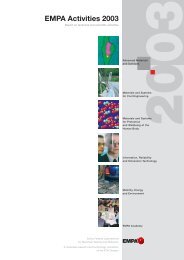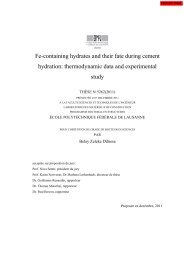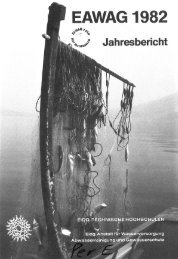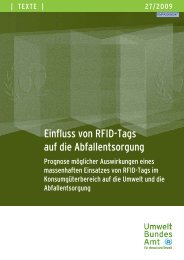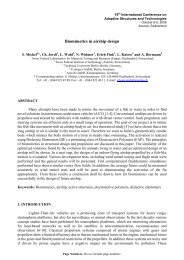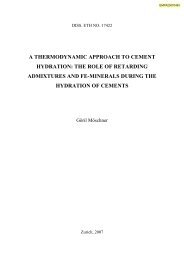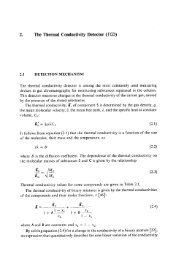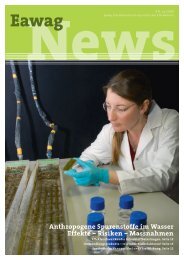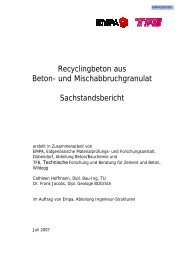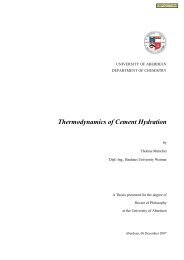Entire volume - Eawag
Entire volume - Eawag
Entire volume - Eawag
You also want an ePaper? Increase the reach of your titles
YUMPU automatically turns print PDFs into web optimized ePapers that Google loves.
Fig. 4: The magnetic field of the solar wind interacts with the magnetic field of the earth. Together they form a natural<br />
protective shield which lowers the amount of cosmic radiation from outer space reaching the earth’s atmosphere.<br />
magnetic field lines, which span the earth<br />
from pole to pole, only permit the charged<br />
particles of the cosmic radiation to enter<br />
the earth’s atmosphere when these have<br />
sufficient energy (more precisely, momentum<br />
per unit charge). The stronger the magnetic<br />
field, the more effectively it shields the<br />
earth from cosmic radiation, resulting in<br />
lower rates of production of 10Be. Analyses<br />
of volcanic rock and sediments show that<br />
the earth’s magnetic field has clearly varied<br />
over the past millennia. As expected, these<br />
fluctuations were recorded in the ice and<br />
can be reconstructed (see article by J. Beer<br />
on p. 14).<br />
Ice Cover as a Climate<br />
Parameter<br />
Ice provides not only a valuable record of<br />
solar activity and the magnetic field. Further<br />
information about the climate can be<br />
gleaned from historical records of lake ice<br />
cover (see article by D. Livingstone on<br />
p. 19). For example, the calendar date of<br />
freeze-up of Lake Suwa in Japan has been<br />
documented almost continuously since<br />
1443. This unique data set has been used in<br />
many historical climatological studies of the<br />
North Pacific region. The longest data set<br />
from a Swiss lake is that of the calendar date<br />
of ice break-up on Lej da San Murezzan,<br />
which dates back to 1832. A further investigation<br />
pursued the question of whether<br />
there is a connection between the ice cover<br />
of lakes and the North Atlantic Oscillation<br />
(see article by D. Livingstone on p. 23). The<br />
North Atlantic Oscillation is a “see-saw” in<br />
surface atmospheric pressure between the<br />
5 EAWAG news 58<br />
Azores High and the Iceland Low. In winter,<br />
it results in variations in the strength of the<br />
westerly winds that transport relatively<br />
warm, moist, maritime air eastwards over<br />
Europe. These variations result in corresponding<br />
variations in the severity of winter<br />
in Europe and much of central Asia, which<br />
are reflected in the timing of thawing of ice<br />
on lakes in these regions [4].<br />
Ice from Methane Hydrate<br />
And lastly, we leave ice as a tracer of past<br />
climate and turn to methane hydrate. This is<br />
a compound of ice (i.e., water) and methane.<br />
It is formed at low temperatures and high<br />
pressure – e.g., in deep sea sediments –<br />
and is stable only under such conditions.<br />
The joint project CRIMEA involves an international<br />
group of scientists, including scientists<br />
from EAWAG, who are attempting to<br />
answer the question of whether this methane<br />
hydrate represents a danger to our<br />
environment (see article by C. Schubert on<br />
p. 26). Even a minor change in environmental<br />
conditions – such as a slight increase in<br />
the temperature of the deep-sea water or a<br />
shift in pressure due to sea level variations<br />
– could lead to methane hydrate being released<br />
and decomposing. This could result<br />
in large quantities of methane reaching<br />
the atmosphere. Since methane is one of<br />
the most important greenhouse gases after<br />
carbon dioxide, the consequences for the<br />
climate could be severe [5].<br />
Looking Back to the Future<br />
To predict the future has always been a<br />
dream of mankind. While earlier prophets<br />
were not particularly successful with reading<br />
cards and tea leaves, scientists today<br />
attempt to divine the future climate using<br />
sophisticated computer models. Such computer<br />
models only provide reliable results if<br />
all of the significant processes and their<br />
interactions are correctly parameterized. In<br />
addition, they have to be studied on a sufficiently<br />
long timescale. We can only hope to<br />
foresee future climate change if we are able<br />
to understand past climate changes. A good<br />
prophet therefore takes a long hard look at<br />
the past.<br />
Jürg Beer, physicist and leader<br />
of the Radioactive Tracers group<br />
in the Department of Surface<br />
Waters, is a titular professor at<br />
ETH Zurich. Research area: cosmogenic<br />
radionuclides; effect of<br />
solar activity on the climate.<br />
[1]Bradley R.S. (1985): Climate and climate variability.<br />
In: Quaternary Paleoclimatology – Methods of Paleoclimatic<br />
Reconstruction (ed. R.S. Bradley). Allen and<br />
Unwin, Boston, p. 11–46.<br />
[2] Beer J. (1995): Climate information from polar ice<br />
cores. EAWAG news 38e, 3–5.<br />
[3] Beer J., Mende W., Stellmacher R. (2000): The role<br />
of the Sun in climate forcing. Quaternary Science Reviews<br />
19, 403–415.<br />
[4] Straile D., Livingstone D.M., Weyhenmeyer G.A.,<br />
George D.G. (2003): The response of freshwater ecosystems<br />
to climate variability associated with the Nord<br />
Atlantic Oscillation. In: The North Atlantic Oscillation –<br />
Climatic Significance and Environmental Impact (ed.<br />
J.W. Hurrell). American Geophysical Union, Washington,<br />
p. 263–279.<br />
[5] Kvenvolden K.A. (1988): Methane hydrates and global<br />
climate. Global Biogeochemical Cycles 2, 221–229.




